In 2006, X-Rite acquired the Munsell Color Company. Along with that acquisition came an important legacy of color science, color standards, and color vision analysis tools.
Today we'll look back at Albert Munsell's contribution to the world of color and share the products his work has inspired to help us manage color in a range of industries, including packaging, apparel, footwear, electronics, cosmetics, home furnishings, paint, food and beverage, construction, and more.
Albert Munsell's Role in the History of Color Analysis
Albert Munsell was among the first people of our century to provide us with a greater understanding of our visual system. His empirical analysis of color organization is the foundation of all modern color coordinate systems.
Munsell Color Order System
Albert Munsell was a college professor in the Boston area. He was an adept artist and a graduate of the Julian Academy of Art in Paris. Munsell would go outside to paint scenery by day, then return to his studio in the evening and continue to paint by lamp light. The following day he would return to the outdoors to continue. He quickly noticed that the colors he painted at night did not match the colors he painted during the day.
Munsell decided he needed a way to organize and describe colors so that he could continue to paint in the evening and get the proper colors. By describing the colors by number and recording the number, he thought could reproduce a color without having to see the original.
Munsell Color Space
Many different people have suggested schemes for color order systems over the years, but the most accepted and utilized is the one described by Munsell: a 3-dimensional space in which hue changes are organized around the circumference.
How the Munsell Color System Helps Communicate Color
Munsell's ideas about how we see and organize colors have stood the test of time. While Munsell’s work was empirical rather than analytical, his model of color remains the general template for all numerical color mapping systems.
Hue
More than any other attribute, hue is what we mean when we think color. Blood red, candy apple red, fire engine red, barn red, ruby red, bright red, dull red, etc. These reds are all different, yet somehow of the same family. Hue is the attribute of a color by which we distinguish red from green, blue from yellow, and so forth.
While there are many ways to present a variety of hues, Munsell chose a circle to organize each of the major hue differences around the circumference and also account for the subtle hue differences as one color blends into another. Reds shift towards orange, oranges toward yellows, yellow towards greens, etc.
Value
Lighter and darker colors slice through the center of Munsell’s color model. At the bottom is pure black, and at the top, pure white. Note that the light/dark axis is colorless - a series of differing grays or achromatic shades to which no color family can be assigned. Albert Munsell used the word Value to describe a color’s lightness. While his terminology is rarely used today, the concept of lightness as a separate attribute of color remains central to all color coordinate methods. There are light blues and dark blues; light greens and dark greens, etc..
Chroma
As a color moves outward from the axis, grayness decreases and strength and purity increase. At this point a family name, such as orange, can be assigned. Duller colors exist toward the center and become stronger and cleaner as they approach the outer circumference.
We often describe strong colors as bright, rich or clean. Similarly, we describe weak colors as dirty, dull, or gray. This property wherein a color seems vibrant and strong to the eye is an attribute that Munsell coined Chroma. Chroma is different from lightness or hue. It represents a third direction in which a color may move. In Munsell’s notation, a low chroma color has a small value (0 equaling no chroma – achromatic).
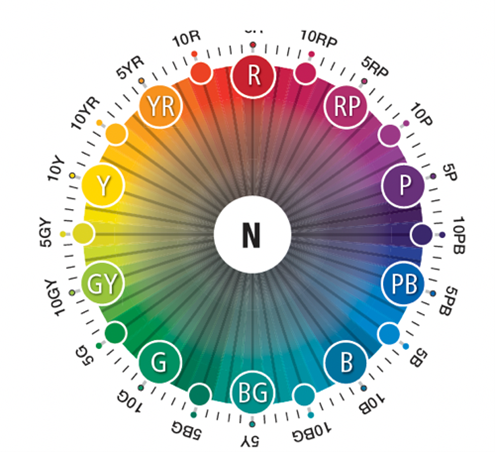
The Shape of Color Space
Where it gets confusing is it is possible to have a strong, rich, full red that is also very light or dark in color. The physics of color and the range of shades or strengths, possible by whatever process, are strongly linked to the color’s position on a scale of lightness and are equally bound by the family from which that color is conceived. Value is denoted from 0 to 10, where 0 would be (if it existed) absolute black (chroma would not exist here), and 10 (if it existed, too) absolute white.
Munsell Color Notation H V / C
Munsell hand painted what he considered to be equal, incremental color differences from one step to another for each color family. He collected and bound them into a book, a structured, organized set of colors that theoretically contain all color possibilities. Munsell’s color tree and his book of color were the first tools ever created whereby an artist or client could specify color by number and get almost exactly what he or she specified.
Munsell’s color model is not completely symmetric. Some of this may be due to human ability to see color, but more is related to the availability of real, physical colorants. In fact, the three-dimensional world of color in the 1940’s (before we knew lead, mercury and other heavy metals were dangerous to our health) was probably a larger model. To protect our children and ourselves, we passed laws to remove these chemicals from our list of available pigments.
10P Purple Family
This is a page from Munsell’s Book of Color that illustrates the Purple family. Also evident is the idea of value and chroma. Notice these shades are clearly grouped by their major hue, and differences from lower left to upper right are in lightness (value) and color strength (chroma). The family (purple) remains constant.
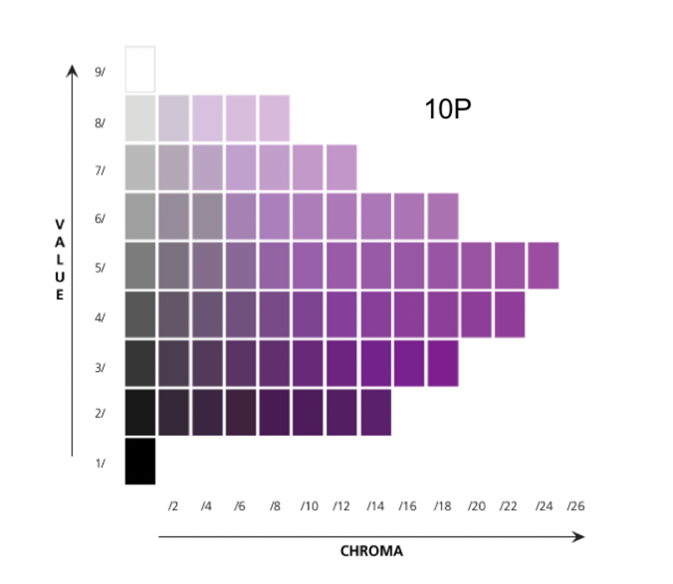
10YR YellowOrange Family
Compare and contrast the Purple family to the YellowOrange family. The Purple family is “fatter” near the middle of the value scale then squeezes in toward the top. Low chroma colors tend to be confusing until the Munsell system demonstrated the color relationships.
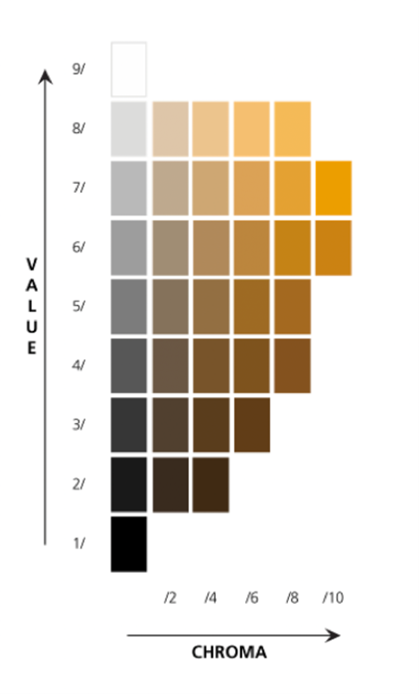

Color Control Solutions Inspired by Munsell
Thanks to Munsell's work, we can provide tools to help define, communicate, and evaluate color. Whether you’re designing palettes, producing products, or conducting color-based analysis, X-Rite offers a offers a variety of resources to transform Munsell color theory into action.
Color Vision and Color Discrimination Testing
Everyone perceives color differently, which is why it is important to understand the vision acuity of anyone involved in color-critical applications. The Munsell Color Order System is an accepted method, worldwide, for precise color specification that has been in use for more than 40 years.
Farnsworth Munsell 100 Hue Test
The Farnsworth-Munsell 100 Hue test is designed to determine if an individual has normal color vision. This test is administered under controlled lighting conditions and requires from 15 to 30 minutes to complete. The test is very simple and consists of a series of colored chips that vary slightly in shade one from the next. The task is to order colored chips into a series of continuously shifting hues.
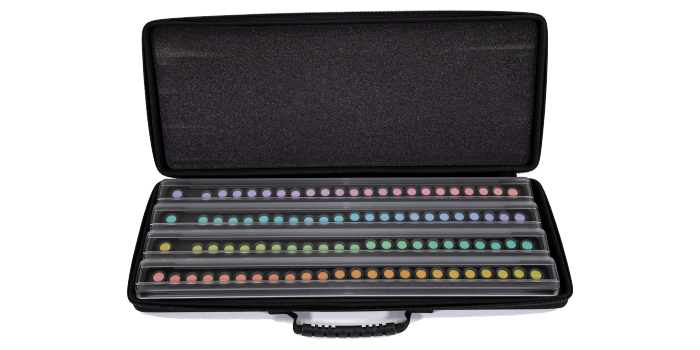
Farnsworth-Munsell 100 Hue Scoring Software
The Farnsworth-Munsell Hue Test Scoring Software can expedite and simplify scoring of the FM 100 Hue Test and take advantage of its powerful set of analytical and administrative tools. Results can be saved, displayed in polar or linear format, and filtered or analyzed according to a variety of algorithms.
Farnsworth-Munsell Dichotomous D-15 Test
for organizations that need to evaluate color discrimination quickly, the Farnsworth-Munsell Dichotomous D-15 Test may be the answer. This abridged version of the FM 100 Hue Test quickly evaluates whether an individual has the aptitude to see color in a normal way. The test consists of a reference cap and 15 removable chips of incremental hue variation.
Color Standards
No matter the industry, consistency and exacting data are essential to every color quality control program. Whether you’re communicating color, making color decisions, or conducting diagnostics testing based on color, you can rely on Munsell Color standards.
Munsell Color Standards
If you’re a supplier to government and industry accurate color influences more than aesthetics. It influences safety, costs, and product quality. Learn about the latest Government and industry color standards available including NEMA, USDA, ANSI, Electric Power Industry Standards, Neutral Value Gray Scales, and more.
USDA Color Standard
Produce is graded in part based on color. Munsell USDA Color Standards, developed in collaboration with the USDA, help agriculture professionals determine when to pick produce and how to grade it based on color and food processors to evaluate color at various phases during processing and packaging.
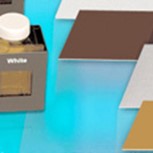
Munsell Neutral Value Gray Scales
Munsell neutral color charts can be used for instrumental calibration, imaging testing or as reflection standards.
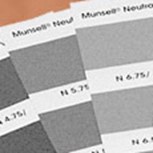
Munsell NEMA Color Standards Family
Munsell developed the NEMA Safety Color Standards family on behalf of National Electrical Manufacturer’s Association (NEMA) and the American National Standard Institute [ANSI Z535.1-2006 (R2011)] ANSI to specify color to manufacturers and verify the product visually matches the specified color.

Munsell Electric Power Industry Standard
These four color standards represent legacy electric power industry standards.

Munsell Color Coding Charts
These charts include a center (centroid) color of each wire color code, which represents the ideal color, as well as several permissible color variations or tolerances around it. The color tolerances represent the maximum allowable visual color variations to accommodate manufacturing variables in the production of electrical wires, which can affect wire color.
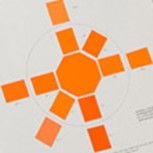
Munsell ANSI Color Standards
ANSI specifications spell out ANSI color standards for safety and other applications where neutral gray colors are required. Each ANSI standard is designed to help you visually match the color you’re producing to ANSI specifications.
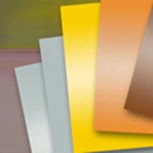
Government Color Standards
For more than 70 years, Munsell standard color charts have helped aerospace suppliers, food processors, and manufacturers of wire and cable apply color standards to comply with government regulations.
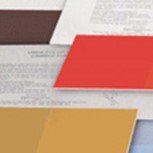
Munsell Custom Color Standards
Along with its huge library of color standards, Munsell Color can also produce custom physical standards to help you validate your specific colors and processes. Custom Munsell Color standards allow you to specify the color you want, plus determine the correct appearance aspects for reproduction, including texture, gloss, fluorescence, and special effects. Learn more in this blog.
Learn More About Color Theory
If you want to learn more foundational color knowledge, gain an understanding of color measurement and data, and define a reliable color quality program, our Fundamentals of Color and Appearance (FOCA) course is for you.
FOCA Seminars
This one-day seminar is built for quality control & assurance professionals, lab technicians, parts suppliers, manufacturing specifiers, or anyone who evaluates or approves color. You’ll walk away with a solid foundation in color and appearance science. From the physics of color to lighting, spectrophotometers, and color data, we will teach you how to measure, view and understand color data.
FOCA Online
Experience 5 hours of videos and interactive content, any time of the day and at your own pace. You will receive a digital course book to follow along and use for future reference, as well access to interactive learning activities. Our discussion boards let you post questions and interact with our Color Experts as well as fellow students.
